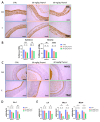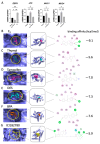Thymol Impacts the Progression of Endometriosis by Disrupting Estrogen Signaling Pathways and Inflammatory Responses
- PMID: 39684860
- PMCID: PMC11642495
- DOI: 10.3390/ijms252313150
Thymol Impacts the Progression of Endometriosis by Disrupting Estrogen Signaling Pathways and Inflammatory Responses
Abstract
Endometriosis is a chronic inflammatory, estrogenic disorder caused by endometrial tissue growth places other than uterine lumen, resulting in infertility and severe pelvic pain. Thymol, an extract of Thymus vulgaris, processes diverse biological properties, including anti-inflammatory, local anesthetic, decongestant, and antiseptic effects. However, the efficacy of thymol in treating endometriosis has still not been explored. Herein, this research aimed to investigate the role of thymol in the treatment of endometriosis using a murine model and Ishikawa cells. Thirty C57BL/6 mice were administered 17β-E2 (100 ng/mouse) subcutaneously for three consecutive days to induce synchronous estrus. On the last day of injection, the mice underwent surgical induction of endometriosis. After that, the mice were divided into three groups, i.e., Control (CTRL), Thymol 30 mg/kg and Thymol 60 mg/kg, receiving oral administration of either saline or thymol (30 mg/kg/d or 60 mg/kg/d, as 0.1 mL/kg/d, respectively) for a three-week duration. Each group consisted of ten mice and was evenly divided into estrus and diestrus according to the vaginal cytology on the last day of treatment. Thymol significantly (p < 0.05) reduced the weight and volume of ectopic tissue, hindered cell proliferation, and stimulated apoptosis compared to the CTRL group. Additionally, in the thymol-treated group, the levels of pro-inflammatory cytokines, tumor necrosis factor-α (TNF-α), interleukin (IL)-1β, and IL-6, as well as the numbers of neutrophils and macrophages, were significantly (p < 0.05) decreased. Moreover, a novel role of thymol in rebalancing estrogen and progesterone (E2-P4) signaling was explored, and it was distributed in the ectopic endometrium. Next, the role of thymol on Ishikawa cells was determined. The results demonstrated that thymol significantly (p < 0.05) suppressed the E2-induced proliferation of Ishikawa cells. Furthermore, molecular docking analyses suggested that thymol potentially binds to ESR1-like estrogens, indicating its antagonistic activity against estrogens. The estrogen receptor 1 (ESR1) and its target gene expression exhibited significant (p < 0.05) downregulation, while progesterone receptor (PGR) and target genes were markedly (p < 0.05) upregulated following thymol treatment in the ectopic endometrium. Most importantly, our data revealed the minimal impact of thymol treatment on the eutopic endometrium and its crucial role in supporting pregnancy, thus indicating the safety of thymol in treating endometriosis. Overall, our study suggests that thymol holds promising therapeutic implications for endometriosis by virtue of its anti-inflammatory properties and ability to antagonize estrogen activity.
Keywords: endometriosis; estrogen signaling; inflammation; thymol.
Conflict of interest statement
The authors declare no conflicts of interest.
Figures








References
MeSH terms
Substances
Grants and funding
LinkOut - more resources
Full Text Sources
Medical
Research Materials
Miscellaneous

